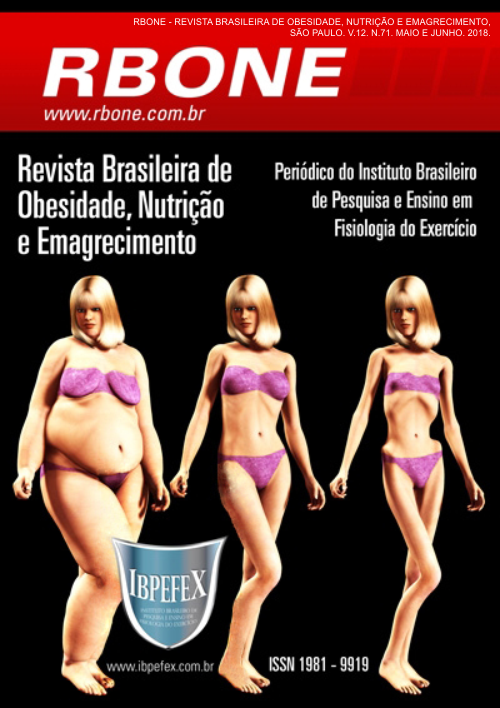Satisfaction of body image in young group gymnastics practice
Abstract
Introduction: Many young people today seek as academies, not only in search of a healthy body and quality of life, but also by the influence of the media and social networks, which impose stereotyped aesthetic standards; This can cause distortion of your real body image. Objective: To evaluate a corporal satisfaction in young gymnastic practitioners. Methodology: A silhouette scale for Brazilian adults and the Body Shape Questionnaire (BSQ) were used. Descriptive statistics were used, by means of frequency, mean, standard deviation. An analysis of the data was performed using the statistical program SPSS (version 20.0), adopting a level of significance of 5%. Results: It was observed that 51.85% of the sample is satisfied with their own body image, and according to a Scale of Silhouettes only 22.22% is identified with images compatible with their reals. Discussion: It should be stressed that the Physical Education professional must know an importance of the body image, considering how the individual's experiences and influences try to avoid exaggeration without incentive to practice physical activity, taking into account a biological individuality and the limits of each person's body. Conclusion: From the results found on a scale of Silhouettes, most volunteers find themselves dissatisfied with a body image. However, BSQ has shown that a large number of group gymnastics practitioners are satisfied. Possibly this difference of results occurred, due to the greater ease of interpretation in response to the questionnaire of silhouettes scale, BSQ being an extensive instrument, which requires a greater time to answer it.
References
-Bôas, M.S.V.; e colaboradores. Nível de satisfação com a imagem corporal e a aparência muscular em praticantes de musculação. Revista da Educação Física/UEM. Maringá. Vol. 21. Num. 3. 2010. p. 493-502.
-Coelho, F.D.; e colaboradores. Comparação da satisfação corporal entre praticantes de diferentes tipos de atividade física. Motricidade. Vila Real. Portugal. Vol. 8. Num. S2. p. 964-969. 2012.
-Cooper, P.; e colaboradores. The Development and Validation of the Body Shape Questionnaire. International Journal of Eating Disorders. Vol. 6. Num. 4. p. 485-494. 1987.
-Damasceno, V.O.; Vianna, V.R.A.; Vianna, J.M.; Lacio, M.; Lima, J.R.P.; Novaes, J.S. Imagem corporal e corpo ideal. Revista Brasileira de Ciência e Movimento. Brasília. Vol. 14. Num. 2. 2006. p. 81-96.
-Di Pietro, M. C. Validade interna, dimensionalidade e desempenho da escala BSQ -“Body Shape Questionnaire” em uma população de estudantes universitários. 36f. Escola Paulista de Medicina, Universidade Federal de São Paulo. Dissertação de Mestrado em Psiquiatria. Universidade Federal de São Paulo. São Paulo. 2001.
-Estevão, A.; Bagrichevsky, M. Cultura da “corpolatria” e body-building: notas para reflexão. Revista Mackenzie de Educação Física e Esporte. São Paulo. Vol. 3. Num. 3. 2004. p. 13-25.
-Fermino, R.C.; Pezzini, M.R.; Reis, R.S. Motivos para a prática de atividade física e imagem corporal em frequentadores de academia. Revista Brasileira de Medicina do Esporte. Vol. 16. Num. 1. 2010. p. 18-23.
-Frois, E.; Moreira, J.; Stengel, M. Mídias e a imagem corporal na adolescência: o corpo em discussão. Psicologia em Estudo. Maringá. Vol. 16. Num. 1. 2011. p. 71-77.
-Guzzo, M. Riscos da beleza e desejos de um corpo arquitetado. Revista Brasileira de Ciências do Esporte. Vol. 27. Num. 1. 2005. p. 139-152.
-Kakeshita, I. S. Adaptação e validação de escalas de silhuetas para crianças e adultos brasileiros. Faculdade de Filosofia, Ciências e Letras de Ribeirão Preto, Universidade de São Paulo. Tese de Doutorado em Psicobiologia. USP. Ribeirão Preto. 2008.
-Matesco, V.M.R. Distorção da imagem corporal e riscos a transtornos alimentares em indivíduos do sexo feminino praticante de musculação de uma academia de Canoas. Centro Universitário La Salle. Trabalho de Conclusão de Curso de Licenciatura em Educação Física. Centro Universitário La Salle-UNILASALLE. Canoas. 2007.
-Pereira Junior, M.; Campos Junior, W.; Silveira, F.V. Percepção e distorção da autoimagem corporal em praticantes de exercício físico: A importância do exercício físico na imagem corporal. Revista Brasileira de Nutrição Esportiva. São Paulo. Vol. 7. Num. 42. 2013. p. 345-352. Disponível em: <http://www.rbne.com.br/index.php/rbne/article/view/410/394>
-Pereira, A.L. Para uma visão fenomenológica do corpo contemporâneo -contributo a partir do alpinismo e das ginásticas de academia. Faculdade de Desporto da Universidade de Porto. Dissertação de Doutoramento em Ciências do Desporto. FCDEF-UP. Porto. 2004.
-Stunkard, A.J.; Sorenson, T.; Schulsinger, F. Use of the Danish adoption register for the study of obesity in thinness. In: Kety, S.; Rowland, L.P.; Sidman, R.L.; Matthysse, S.E. (Eds.). The genetics of neurological and psychiatric disorders. New York: Raven. p. 115-120. 1983.
-Vidal, A.R.C. Satisfação com a Imagem Corporal em Praticantes de Ginástica de Academia. Estudo Comparativo entre Praticantes de Musculação e Ginástica de Grupo. Faculdade de Desporto da Universidade de Porto. Dissertação de Licenciatura. Universidade de Porto. Porto. 2006
Authors who publish in this journal agree to the following terms:
- Authors retain the copyright and grant the journal the right of first publication, with work simultaneously licensed under the Creative Commons Attribution License BY-NC which allows the sharing of the work with acknowledgment of the authorship of the work and initial publication in this journal.
- Authors are authorized to enter into additional contracts separately for non-exclusive distribution of the version of the work published in this journal (eg, publishing in institutional repository or book chapter), with acknowledgment of authorship and initial publication in this journal.
- Authors are allowed and encouraged to post and distribute their work online (eg, in institutional repositories or on their personal page) at any point before or during the editorial process, as this can bring about productive change as well as increase impact and impact. citation of published work (See The Effect of Free Access).






